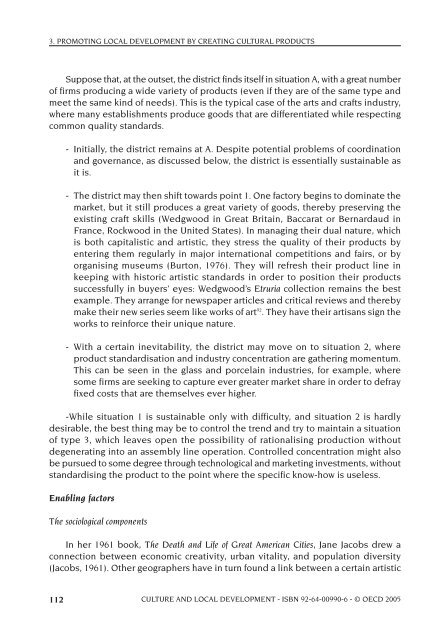OECD Culture and Local Development.pdf - PACA
OECD Culture and Local Development.pdf - PACA
OECD Culture and Local Development.pdf - PACA
Create successful ePaper yourself
Turn your PDF publications into a flip-book with our unique Google optimized e-Paper software.
3. PROMOTING LOCAL DEVELOPMENT BY CREATING CULTURAL PRODUCTS<br />
Suppose that, at the outset, the district finds itself in situation A, with a great number<br />
of firms producing a wide variety of products (even if they are of the same type <strong>and</strong><br />
meet the same kind of needs). This is the typical case of the arts <strong>and</strong> crafts industry,<br />
where many establishments produce goods that are differentiated while respecting<br />
common quality st<strong>and</strong>ards.<br />
- Initially, the district remains at A. Despite potential problems of coordination<br />
<strong>and</strong> governance, as discussed below, the district is essentially sustainable as<br />
it is.<br />
- The district may then shift towards point 1. One factory begins to dominate the<br />
market, but it still produces a great variety of goods, thereby preserving the<br />
existing craft skills (Wedgwood in Great Britain, Baccarat or Bernardaud in<br />
France, Rockwood in the United States). In managing their dual nature, which<br />
is both capitalistic <strong>and</strong> artistic, they stress the quality of their products by<br />
entering them regularly in major international competitions <strong>and</strong> fairs, or by<br />
organising museums (Burton, 1976). They will refresh their product line in<br />
keeping with historic artistic st<strong>and</strong>ards in order to position their products<br />
successfully in buyers’ eyes: Wedgwood’s Etruria collection remains the best<br />
example. They arrange for newspaper articles <strong>and</strong> critical reviews <strong>and</strong> thereby<br />
make their new series seem like works of art 92 . They have their artisans sign the<br />
works to reinforce their unique nature.<br />
- With a certain inevitability, the district may move on to situation 2, where<br />
product st<strong>and</strong>ardisation <strong>and</strong> industry concentration are gathering momentum.<br />
This can be seen in the glass <strong>and</strong> porcelain industries, for example, where<br />
some firms are seeking to capture ever greater market share in order to defray<br />
fixed costs that are themselves ever higher.<br />
-While situation 1 is sustainable only with difficulty, <strong>and</strong> situation 2 is hardly<br />
desirable, the best thing may be to control the trend <strong>and</strong> try to maintain a situation<br />
of type 3, which leaves open the possibility of rationalising production without<br />
degenerating into an assembly line operation. Controlled concentration might also<br />
be pursued to some degree through technological <strong>and</strong> marketing investments, without<br />
st<strong>and</strong>ardising the product to the point where the specific know-how is useless.<br />
Enabling factors<br />
The sociological components<br />
In her 1961 book, The Death <strong>and</strong> Life of Great American Cities, Jane Jacobs drew a<br />
connection between economic creativity, urban vitality, <strong>and</strong> population diversity<br />
(Jacobs, 1961). Other geographers have in turn found a link between a certain artistic<br />
112 CULTURE AND LOCAL DEVELOPMENT - ISBN 92-64-00990-6 - © <strong>OECD</strong> 2005














